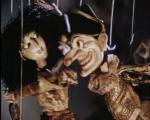You are currently browsing the category archive for the ‘Soyuzmultfilm’ category.
Director: Fyodor Khitruk
Release date: 1962
Rating: ★★★★
Review:
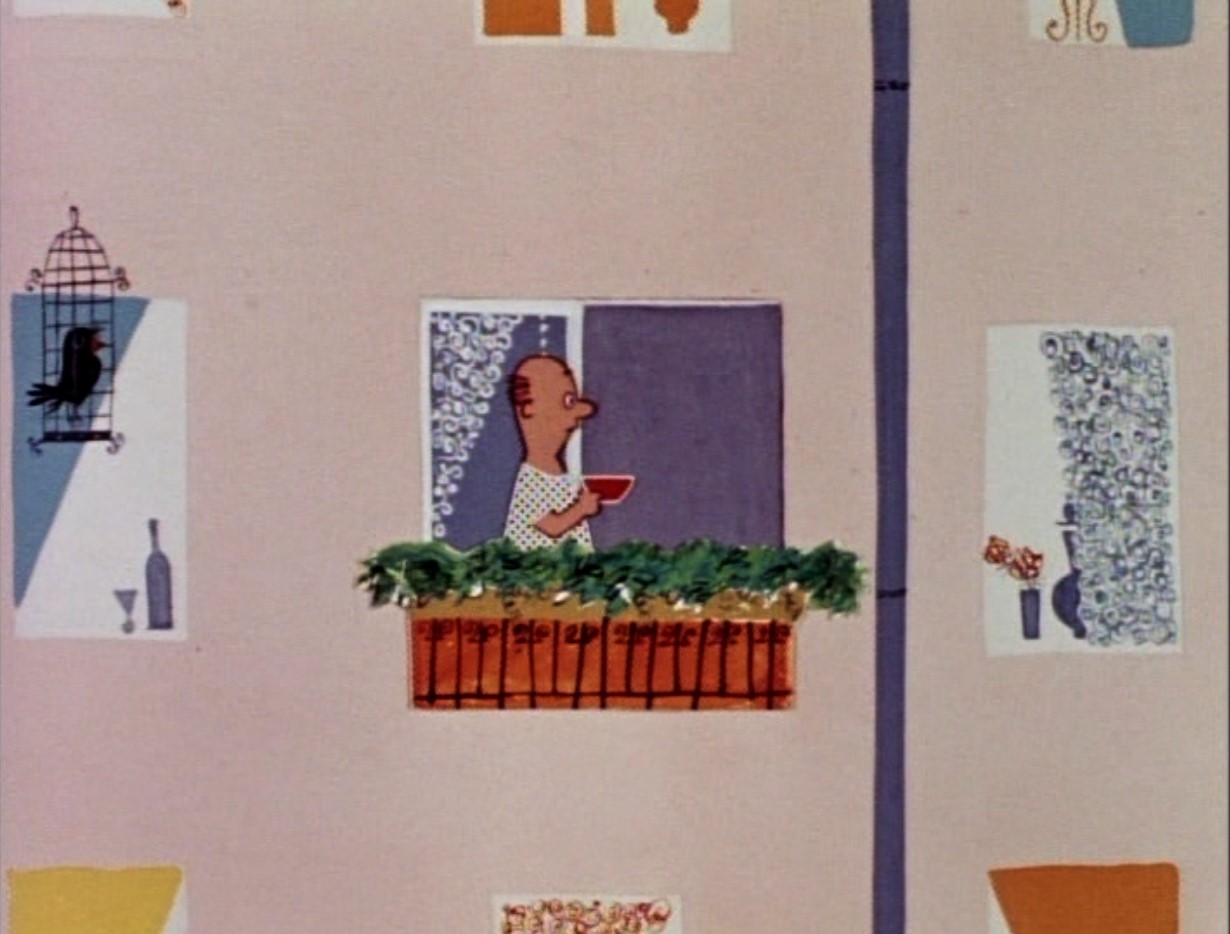
‘Story of One Crime’ was the first film directed by acclaimed film maker Fyodor Khitruk (1917-2012). Khitruk was one of the best comic talents in the Soviet era, as is already visible in this delightful early film.
The short starts with a man sneaking upon two talking ladies and hitting them with a large pan. At that point the narrator interrupts and takes us viewers 24 hours back. The rest of the film is told wordlessly, and shows the criminal, comrade Manin, to be a nice, gentle and hard working man. We watch him going to work, and working at the office.
All seems well, but as soon as he returns to his home, in an apartment block, the problems start. When he wants to rest on his balcony, he’s disturbed by ridiculously loud domino players playing in the courtyard. When he returns inside to watch some television, a neighbor turns on some loud jazz music, and later, when he tries to sleep, more neighbors deprive him of a good night’s rest in various ways. The film ends with a message to the viewers themselves, no doubt, more often than not living in such noisy apartments themselves.
Khitruk tells his tale with an understated sense of humor, and a relaxed, but effective sense of timing. The animation is limited, and far from fluent, but as Khitruk knows how to pose, very effective. The designs by Sergei A. Alimov, too, are a delight: the film is a rare example of Soviet cartoon modern design, and both characters and backgrounds are gorgeous throughout the film. They are partly made by snippets from magazines, and especially the neighbor’s gargantuan stereo installation is a great example of good cut and paste work.
With ‘Story of One Crime’ Khitruk took Soviet animation away from the classic fairy tale worlds of the 1950s into the modern age. The film contains some criticism on Soviet society, which is depicted as less than ideal, but the film was an enormous success, nonetheless.
With this short Khitruk immediately became one of the Soviet Union’s most important animation film makers, as he would prove, e.g. by delivering the world his delightful ‘Vinnie Puch’ (Winnie the Pooh) films of 1969-1972.
Watch ‘Story of One Crime” yourself and tell me what you think:
‘Story of one Crime’ is available on the DVD ‘Masters of Russian Animation Volume 1’
Director: Fyodor Khitruk
Release date: 1973
Rating: ★★★★
Review:

‘The Island’ is a short gag film in which a bearded castaway is stranded on a tiny island.
Khitruk explores this traditional cartoon setting, and brings it into new directions. The man longs to be rescued, but nobody helps him, though the ocean turns out to be very crowded, indeed. In fact, in the end, the man is far worse off than he was in the beginning.
Khitruk’s cell animation is effective, his designs are charming, and his timing is excellent. But the film is more than just a mere series of gags, as Khitruk satirizes man’s aggression, greed, emptiness and folly. It’s signifying that the only person helping the main protagonist, is one who has even less than the castaway he helps. Thus ‘Island’ is more than just a little gag film, it’s a humorous essay on the human condition, and it’s not an optimistic one.
Watch ‘The Island’ yourself and tell me what you think:
‘The Island’ is available on the DVD ‘Masters of Russian Animation Volume 2’
Director: Yuri Norstein
Release date: 1973
Rating: ★★★★
Review:
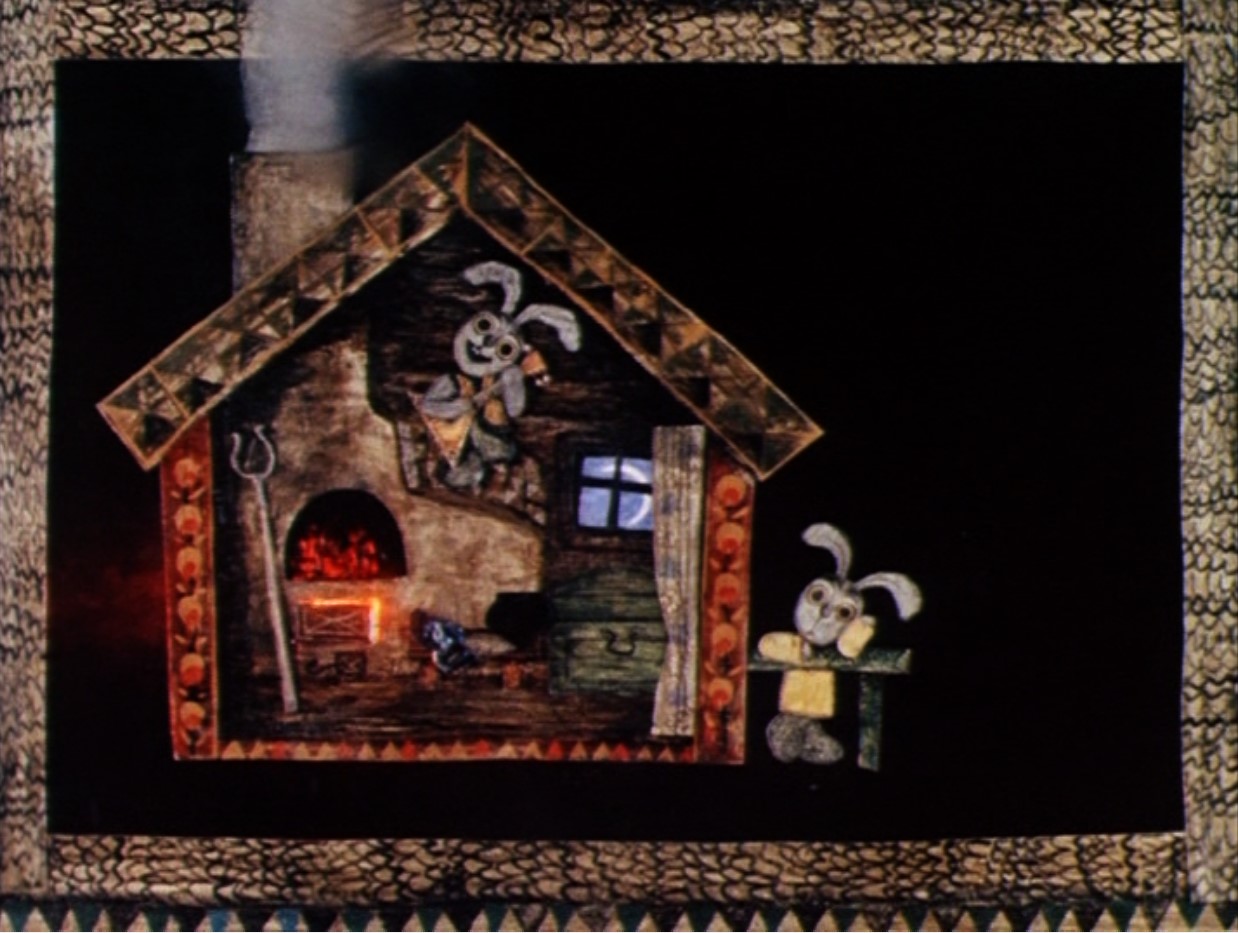
In ‘Fox and Rabbit’ (actually Fox and Hare) Norstein retells a Russian folktale in which a fox chases a rabbit out of his own house. A wolf, a bear and a bull all three promise the rabbit to help him regain his house, but when threatened by the fox they run off. Only a small rooster at least tries it.
The story is told by a voice-over, and is illustrated in a very charming semi-folkloristic style, which striking and colorful supposedly wooden frames framing the action, as if were looking at paintings. M. Meyerovich’s, rather Stravinsky-like music only adds to the folkloristic character. Norstein’s cut-out animation, meanwhile, is of the highest order, and full of little subtleties, signifying the different characters.
‘Fox and Rabbit’ may be less famous than the later ‘Hedgehog in the fog’ (1975) or ‘Tale of Tales‘ (1979), the film already shows Norstein’s extraordinary talent and charming animation style. Fyodor Khitruk thought highly of the film, and was completely surprised that such commonplace material (Soyuzmultfilm had made fable films for several decades) turned into such an original, idiosyncratic film.
Watch ‘Fox and Rabbit’ yourself and tell me what you think:
‘Fox and Rabbit’ is available on the DVD ‘Masters of Russian Animation Volume 2’
Director: Andrei Khrzhanovsky
Release date: 1973
Rating: ★★★
Review:
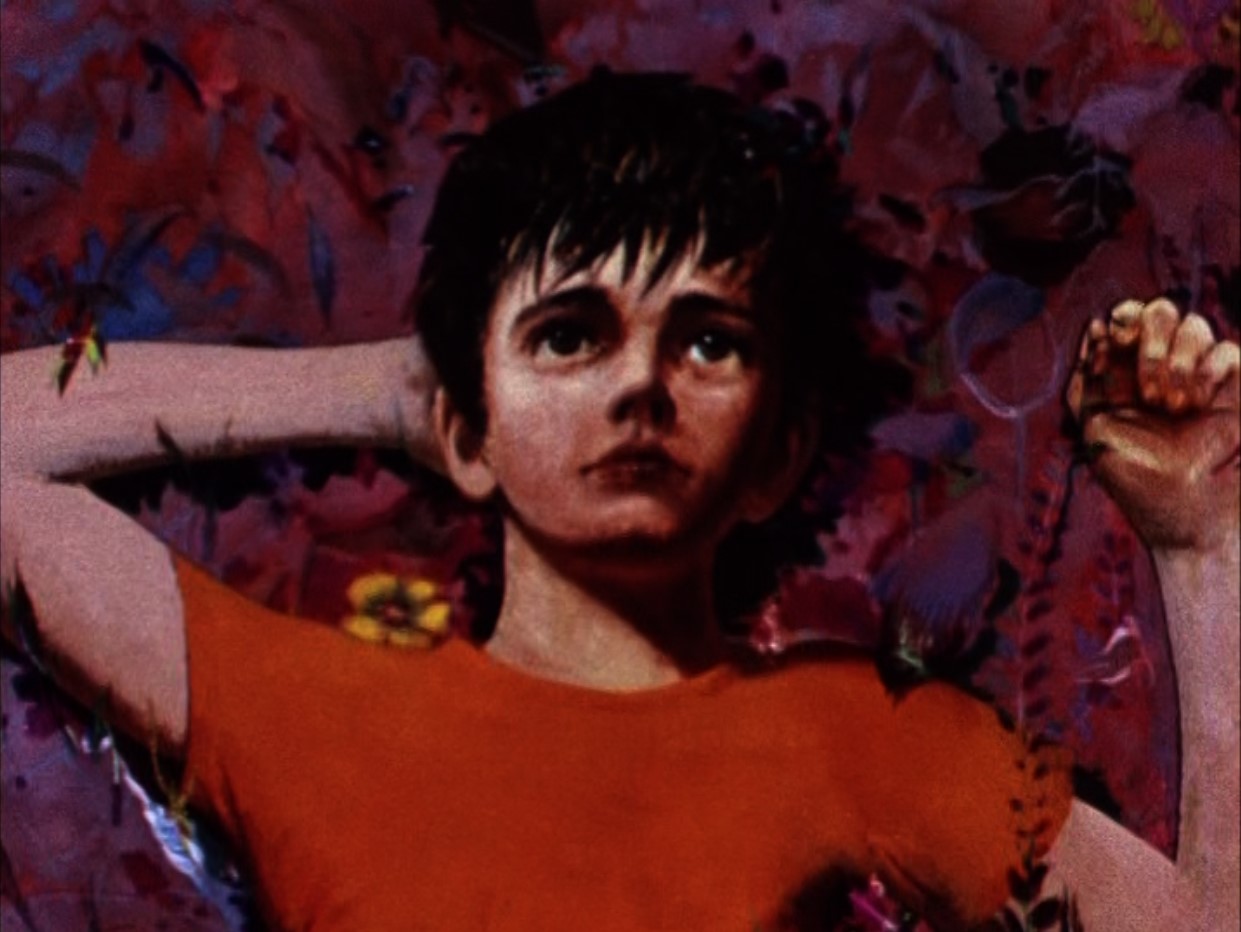
In ‘Butterfly’ a boy catches some butterflies, but after a nightmarish scene in which he himself is trapped, he releases them again.
The plot of ‘Butterfly’ is far from original, and rather predictive and boring, but Khrzhanovsky’s eclectic style is not. Part of the story is told in still oil paintings, but there’s also a little cell animation and cut-out animation.
The oil paintings are most interesting, with their rather high level of realism, and their painful contrast between colorful nature, and the dull, grey world of the modern city. Especially the scene inside the boy’s flat is most depressing, with only grey electronic robots to play with. Nevertheless, the most striking aspect of this film are not the animation nor the visuals, but the fascinating score by avant-garde composer Alfred Schnittke.
Watch ‘Butterfly’ yourself and tell me what you think:
‘Butterfly’ is available on the DVD ‘Masters of Russian Animation Volume 2’
Directors: Ivan Ivanov-Vano & Yuri Norstein
Release date: 1971
Rating: ★★★
Review:
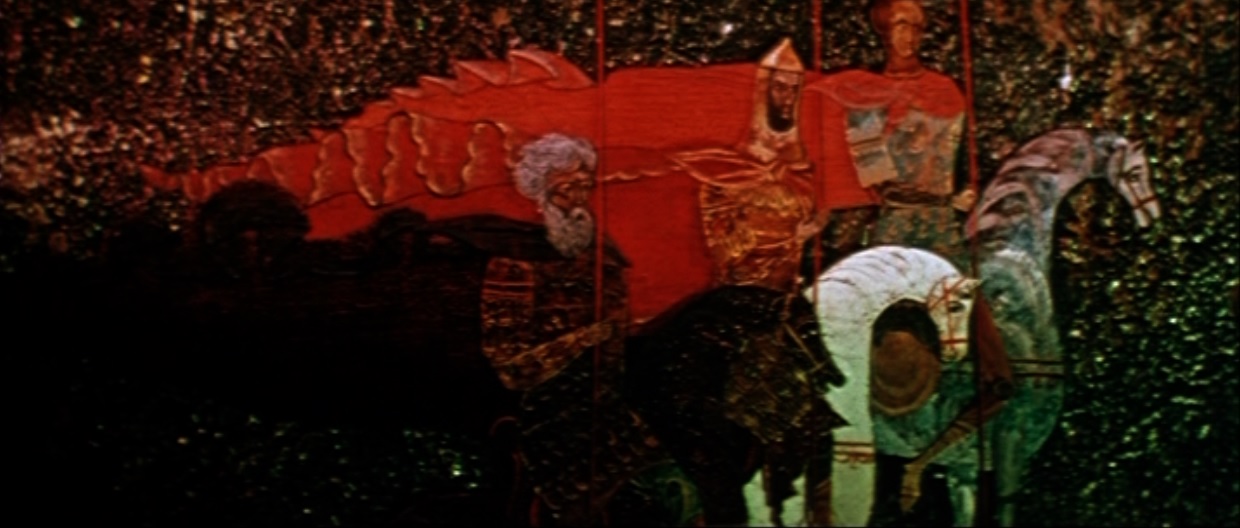
Veteran director Ivan Ivanov-Vano and young and up-and-coming talent Yuri Norstein co-direct the rather enigmatic ‘The Battle of Kerzhenets’.
Set to music by Nikolai Rimsky-Korsakov (excerpts from his opera ‘the Invisible City of Kitezh’), the film tells of a legendary epic battle of a Russian army against an invading army of Mongols, and of its aftermath. The film consists of three parts: in the first we watch the soldiers saying goodbye to their wives and children, the second depicts the battle itself, and the third part shows how life continues, with images of farmers sowing and harvesting and of children playing.
The short stops quite abruptly, and it’s quite unclear what the duo wanted to tell with their film. Nevertheless, the film is a marvel to watch. As the directors state themselves in the opening of the film, the visuals are based on Russian icons and frescos of the 14th to 16th century, and these give the short its unique style.
The cut-out animation is fair, and more emblematic than realistic, but the real treat lies in the way the two directors filmed their short. For a film about a battle, the filming is remarkably poetic: the images often flow into each other by the use of dissolves into black and back, and there’s a lot of soft focus on the images, creating a magical distance. In fact, the images are mesmerizing throughout the picture, and clearly look forward to Norstein’s individual poetic style.
Watch ‘The Battle of Kerzhenets’ yourself and tell me what you think:
‘The Battle of Kerzhenets’ is available on the DVD ‘Masters of Russian Animation Volume 2’
Director: Andrei Khrjanovsky
Release date: 1970
Rating: ★★
Review:

‘Armoire’ is an enigmatic cut-out animation film about a man in an apartment who puts an enormous cupboard into his room. Once inside, he starts to put all his belongings into the cupboard, until he can live inside it. In the end it’s revealed that even his tiny room is inside another cupboard.
Several shots of depressing apartment blocks suggest that this is a critical satire on the living conditions inside the Soviet Union, but I’m not sure. ‘Armoire’ is as avant-garde as was possible in the Soviet-Union, especially Alfred Schnittke’s score is very modernistic. But because the film is just the illustration of one puzzling idea, and because the one protagonist is as phlegmatic as Buster Keaton, the film fails to make a lasting impression.
Watch ‘Armoire’ yourself and tell me what you think:
‘Armoire’ is available on the DVD ‘Masters of Russian Animation Volume 2’
Director: Ivan Ivanov-Vano
Release date: 1969
Rating: ★★½
Review:

‘Seasons’ is a very poetic stop-motion film set to music by Pyotr Ilyich Tchaikovsky.
The film tells about two lovers through the seasons, although we see mostly images of autumn (the two riding together through a forest) and winter (a lengthy sleigh ride), with summer being reduced to a reminiscence of happier times, and spring hardly identifiable, at all.
The film is directed by Ivan Ivanov-Vano, but co-directed by Yuri Norstein, and already contains several elements of the later director’s mature style: the stop-motion is close to cut-out animation, there are plenty multi-plane effects, and the filming of the images has a soft, poetic edge to it. The designs are extraordinary beautiful, especially that of the crystalline forest, but as practically nothing happens during the entire film, the result is as enchanting as it is boring.
Watch ‘Seasons’ yourself and tell me what you think:
‘Seasons’ is available on the DVD ‘Masters of Russian Animation Volume 2’
Director: Lev Atamanov
Release date: 1969
Rating: ★★★★
Review:

In ‘Ballerina on the Boat’ a ballerina boards a ship. When she practices her moves, several sailors try to copy her, but only succeed in falling overboard. In the end they all get so angry, the gentle ballerina retreats into her cabin. But that night she rescues the ship from a terrible storm.
‘Ballerina on the Boat’ is a very charming film using stark cartoon modern designs and watercolor backgrounds reminiscent of Raoul Dufy. Even the storm consists of beautifully colored paint strokes. The film thus has a strong 1950s feel, enhanced by the peppered modern music by star composer Alfred Schnittke.
The film uses no dialogue and has a very poetic feel, as the ballerina defies gravity more than once. The ballerina herself is animated beautifully and very convincingly, and indeed, two people are credited for choreography. If the film has one drawback, it’s its length. For, after all, not too much is happening throughout the 17 minute long short.
Watch part 1 of ‘Ballerina on the Boat’ yourself and tell me what you think:
‘Ballerina on the Boat’ is available on the DVD ‘Masters of Russian Animation Volume 2’
Director: Valentin Karavaev
Release date: 1970
Rating: ★★
Review:

‘A Lesson Not Learned’ is a rather blatant and vicious Soviet propaganda film suggesting that West Europe is led by fascists trying to restore the Germany of old.
The film starts with images from World War II, accompanied by the sounds of bombs and gunfire. Then we cut to an old Nazi in sheep’s clothing, who seeks refuge in the American-British zone. Accepted and retired, the old Nazi preaches ‘revanchism’, in order to restore Germany’s borders from before World War II. However, he is stopped by the Berlin wall and the peace treaty signed between the USSR and the DDR, in which the current borders are accepted.
This film uses a satirical style more reminiscent of the forties than of the seventies, rendering an old-fashioned imagery. The best idea is the little Hitler angel helping the old Nazi. There’s no dialogue. For example, when the old Nazi starts to speech, we only hear the sound of guns. There’s pretty little animation and the message is emphasized with writings as in political cartoons.
It’s hard to watch a film so full of lies, which shows that up to its very end the Soviet Union partly based its legitimation on the idea that its existence was the only way to stop fascism. And the saddest thing is that the current Russian regime has revived this falsehood to defend its current war in the Ukraine.
Watch ‘A Lesson Not Learned’ yourself and tell me what you think:
‘A Lesson Not Learned’ is available on the DVD set ‘Animated Soviet Propaganda’
Director: Sergei Ryabov
Release Date: February 20, 2007
Rating: ★★★½
Review:
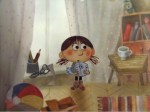 ‘The Tiny Fish’ is a charming little children’s film with a winter setting.
‘The Tiny Fish’ is a charming little children’s film with a winter setting.
We follow a little girl who encounters an evil fisherman catching a fish. Shocked by this event the girl stays at home, leaving it to other kids to play outside in the snow. She draws a picture of the fish and then dreams that she and the fish are attacked by a giant version of the fisherman, who grows bigger and bigger in size. With her paper fish the girl returns to the ice hole where the fish had been caught. She returns her paper fish to the water, which immediately comes to life.
‘The Tiny Fish’ is made with a virtuoso cut-out technique. The designs are soft and tender, if a little old-fashioned. The story is told without words, and with a great feel of atmosphere. The girl’s emotions are not shown all too explicitly, but one immediately feels with her. The magical transformation of the paper fish is in complete agreement with the child’s world of wonder.
Watch ‘The Tiny Fish’ yourself and tell me what you think:
‘The Tiny Fish’ is available on the Belgian DVD ‘Kleine helden & rare kwasten – 14 animatiefilms voor kinderen’
Directors:Ivan Ivanov-Vano & Leonid Amalrik
Release Date: 1933
Rating: ★★★★★
Review:
 Of all animated Soviet propaganda films, ‘Black & White’ certainly is one of the most powerful. The film is essentially silent, but it’s accompanied by the beautiful negro spiritual “Sometimes I Feel Like a Motherless Child” sung in a deep mournful voice.
Of all animated Soviet propaganda films, ‘Black & White’ certainly is one of the most powerful. The film is essentially silent, but it’s accompanied by the beautiful negro spiritual “Sometimes I Feel Like a Motherless Child” sung in a deep mournful voice.
The film is based on a poem of the same name from 1925 by Vladimir Mayakovsky, who wrote the poem during a trip to Cuba. Like the poem, the film shows American racism and the exploitation of black people. We watch them being oppressed by the white, as if they were still slaves, and kept quiet by religion. The images are strong and very stylized. Each image of the film is staged wonderfully to the best effect. A most impressive image is that of numerous blacks in prison, but the bleakest of them all is the final shot of a car passing a lawn with a black man hanging on each tree.
The overall mood of the film is absolutely depressing, especially when one realizes that for once the Soviet propagandists were not too far from the truth. Nevertheless, the Soviet solution, “Lenin”, may be a little too short-sighted, and I doubt whether this film has ever been watched by its intended audience, and if it struck any international chord at all. Who knows? At least, Cuba has been the only country in the Americas to experience a Marxist regime…
Anyhow, despite its abrupt and inapt Lenin-ending, ‘Black & White’ is one of the darkest and strongest of all animated films of the 1930s, and certainly the most interesting animation film to come from the Soviet Union in that decade.
Watch ‘Black & White’ yourself and tell me what you think:
‘Black & White’ is available on the DVD-set ‘Animated Soviet Propaganda’
Director: Fyodor Khitruk
Release Date: 1983
Rating: ★★★★
Review:
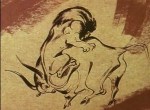 ‘Lion and Ox’ is one of Fyodor Khitruk’s most serious films. It’s a very beautiful short about an ox who befriends a lion. Unfortunately, a devious little fox sets the two against each other, with fatal results.
‘Lion and Ox’ is one of Fyodor Khitruk’s most serious films. It’s a very beautiful short about an ox who befriends a lion. Unfortunately, a devious little fox sets the two against each other, with fatal results.
This simple fable is told without words. They’re not necessary, for the animation is stunning. Apart from the fox, the animals are animated very reallistically, but they still retain a strong sense of emotion, telling the tale in expressions. The designs are very graphic, with beautiful ink lines. The backgrounds, too, are gorgeous, and reminiscent of Chinese paintings in their suggestions of the savanna by using a few powerful paintbrushes.
Watch ‘Lion and Ox’ yourself and tell me what you think:
Director: Grigori Lomidze
Release Date: 1947
Rating: ★★★
Review:
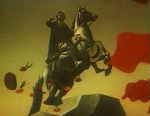 ‘To You, Moscow’ is a long and slow Soviet propaganda film celebrating Moscow’s 800th birthday by depicting its turbulent history.
‘To You, Moscow’ is a long and slow Soviet propaganda film celebrating Moscow’s 800th birthday by depicting its turbulent history.
During the film we watch Moscow’s settlement, the victory of Ivan III over the Tartars (15th century), the revolt against Polish occupation (17th century), the defeat of Napoleon’s army in 1812, the 1905 revolution, the 1917 socialist revolution (‘led by Lenin and Stalin’) and the 1941 defeat of the fascist army to the present day.
The socialist revolution section leads to live-action footage of Moscow, a happy child, flowers, some buildings and street scenes and statues of Lenin and Stalin. The last section, the celebration, shows photographs of heroic inhabitants of the Soviet Union, and not only glorifies Moscow as “our youth, our glory”, “our dear mother” and “our birthday girl”, but also as a “glory to Stalin”.
The different sections are bridged by letters and postcards to comrade Stalin. The sections themselves focus on strives and battles, and are accompanied by alternately realistic and symbolic images. For example, the 1917 revolution is depicted by the czarist double-headed eagle struggling and falling to pieces, while the most impressive part may be that of 1812, with its realistic images of fire.
It may be clear that this film is propaganda at its worst. The film is saved from becoming totally unwatchable by the beautiful animation, the stark images, and the lively patriotic music.
Watch ‘To You, Moscow’ yourself and tell me what you think:
‘To You, Moscow’ is available on the DVD box set ‘Animated Soviet Propaganda’
Director: Mikhail Kamenetsky
Release Date: 1984
Rating: ★★
Review:
 Mikhail Kamenetsky (1924-2006) was a director of numerous puppet films made between 1965 to 1995, almost all featuring animals.
Mikhail Kamenetsky (1924-2006) was a director of numerous puppet films made between 1965 to 1995, almost all featuring animals.
In his ‘Wolf and Calf’ an old wolf steals a calf to eat, but he starts to like it and raises it like his own son. In the end, when a hungry bear, a vixen and a boar try to steal his loot, he is saved by the calf itself, which has turned into a strong bull.
‘Wolf and Calf’ is a fable-like children’s film with an old-fashioned look. The designs of the protagonists look like they have come from a 1950’s toy shop. Kamenetsky’s puppet animation is elaborate, and actually quite good, if erratic, but the film suffers from an excess of dialogue, which not always seems to correspond with the animated characters themselves.
Moreover, the film’s world is rather inconsistent, stretching its believability: the wolf, like all other animals, is highly anthropomorphic and even lives in a house, alongside humans, who are afraid of him nonetheless. The calf, on the other hand, remains on all fours, and stays an animal, even though it is able to speak.
Watch ‘Wolf and Calf’ yourself and tell me what you think:
Director: Yuri Norstein
Release Date: 1979
Rating: ★★½
Review:
 In ‘Tale of Tales’ we’re watching a wolf cub trying to survive his loneliness in an old house, relying on his memories.
In ‘Tale of Tales’ we’re watching a wolf cub trying to survive his loneliness in an old house, relying on his memories.
These images are altered with images of a river scene with a.o. a fisherman, his wife and his children, and a giant Picasso-like minotaur skipping rope. Two other recurring images are that of dancing wives losing their men to war, and that of a little boy eating apples in the snow.
‘Tale of Tale’s is regarded as Yuri Norstein’s masterpiece and as one of the best animation films of all time. This does not mean it is the most accessible of all films, on the contrary. ‘Tale of Tales’ is a poetic film, but a confusing one. The nostalgic images seem unrelated, and are shown in a non-linear fashion. In fact, it is very difficult to render a ‘tale’ out of the images, which are intrinsically very strong, especially those of the melancholy wolf cub and of the iconic river scene.
Most of the film is made of muddy images in sepia-tones, rendering a dreamy atmosphere. Many images return, bridged by the wolf cub character, who, alone, seems to live in the present, outside of the images of a childhood long past. There’s some vague sense of a happy childhood being shattered by war and being lost in time.
The film uses no dialogue, and even the music is timid in its evocation of mood. Some of the cut-out animation is superb, however, and the overall imagery one of great virtuosity. The end result is as beautiful as it is overlong and frustratingly incomprehensible.
Watch ‘Tale of Tales’ yourself and tell me what you think:
Director: Eduard Nazarov
Release Date: 1979
Rating: ★★
Review:
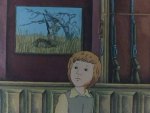 This Soviet animation film starts when a boy enters a hunting shop.
This Soviet animation film starts when a boy enters a hunting shop.
When he looks at a photo of a hunter on top of a dead lion, his imagination starts to wander. He imagines himself in a forest, and on a Savannah, full of wildlife. When encountering the lion, he prevents the hunter from shooting. Unfortunately, he’s awoken by the shop owner.
‘Hunt’ is a silent film, told with realistic images, strong 1970s designs, and dated electronic music. The film’s opening is probably its best: we’re watching images of busy and indifferent city life, before zooming in on the boy. The film clearly celebrates life, especially in the Savannah scenes, which form a rich contrast to the dull city life images. Nevertheless, the film feels traditional and naive, and more as a product of its time than as a timeless classic.
Watch ‘Hunt’ yourself and tell me what you think:
Director: Vladimir Tarasov
Release date: 1988
Rating: ★★★½
Review:
 ‘Pereval’ (The Pass) is a science fiction film from the Soviet Union about three youngsters, descendants of some astronauts stranded on a strange, alien planet, who make a quest to the original spaceship.
‘Pereval’ (The Pass) is a science fiction film from the Soviet Union about three youngsters, descendants of some astronauts stranded on a strange, alien planet, who make a quest to the original spaceship.
The film is dark and moody and the atmosphere contemplative, even in the action scenes. Nevertheless, there is a weak comic relief in the form of an eight-eyed, elephant-like creature, which the youngsters encounter on their way to the ship.
In this film Tarasov uses a bold, realistic style with sharp contrasts: he juxtaposes stark shadows with monochrome yellows and reds to create a unique graphic atmosphere, reminiscent of the work by Frank Miller. The planet is portrayed as barren, disturbing and threatening. The images are often very surreal, and no attemption is made to give the backgrounds any sense of realism. This makes this film comparable to Laloux’s ‘La Planète sauvage‘, despite its difference in style. The spaceship, for example, looks more like an alien temple, and one gets the idea that the journey of the three is more symbolical than real. The mood is enhanced by a Dio-like hard rock song.
‘Pereval’ was the last animation film Tarasov made during the Soviet era. See the modest Wikipedia article to learn what happened to him after the fall of the Soviet Union.
Director: Roman Kachanov
Release date: 1981
Rating: ★★★★
Review:
 ‘Tayna Tretyei Planeti’ (‘The Mystery of the Third Planet’, also ‘[Alice and] The Secret of the Third Planet’) is a delightful science-fiction film for children about the little girl Alice, who accompanies her father, a bespectacled scientist, and the melancholy captain Green on their trips to collect alien animals for the Moscow zoo.
‘Tayna Tretyei Planeti’ (‘The Mystery of the Third Planet’, also ‘[Alice and] The Secret of the Third Planet’) is a delightful science-fiction film for children about the little girl Alice, who accompanies her father, a bespectacled scientist, and the melancholy captain Green on their trips to collect alien animals for the Moscow zoo.
On their way they encounter a mysterious professor, and learn about the illegal slaughter of ‘chatterers’, some kind of alien bird species. The one surviving chatterer provides the key to the mystery, leading our heroes to two heroic astronauts, who have been captured by pirates.
Despite the mystery plot, the overall mood of the film is optimistic, unhurried and relaxed. At no point there’s is any real danger or violence. Even when the villain commits suicide at the end, it turns out to be fake. The film’s delight is not as much found in its story as in its gorgeous designs, its alien images, its surreal backgrounds, Aleksandr Zatsepin’s wonderful soundtrack, full of electronic space-funk, and in its exuberant animation. Alice, for example, has the habit to pull back her hair continuously, while her dad keeps putting his glasses straight. Also featured is a comical alien creature, called Gromozeka, who possesses no less than six arms, which are all animated separately.
It seems that there were no budget problems at Soyuzmultfilm at that time, if animators could indulge that much in excessive animation. The results are gorgeous, but sometimes the elaborate animation slows down the action, especially during the action scenes, which are anything but fast. Nevertheless, ‘Tayna Tretyei Planeti’ is a gem of an animation film, and a feature that definitely deserves to be more well-known, even though it’s a short one, clocking only 45 minutes.
Watch ‘The Mystery of the Third Planet’ yourself and tell me what you think:
Director: Vladimir Tarasov
Release date: 1978
Rating: ★★★
Review:
 ‘Contact’ is a good-humored short film in which a pipe-smoking, nature-loving hippie encounters a multicolored alien, capable of morphing.
‘Contact’ is a good-humored short film in which a pipe-smoking, nature-loving hippie encounters a multicolored alien, capable of morphing.
First the man flees in horror, but then the two make contact through music, and in the end we can see them walking into the distance, singing together.
This Soviet film is surprisingly Western-looking and is drawn in a bold seventies style. In contrast with Tarasov’s earlier ‘Forward March, Time!‘ any Soviet association is lacking, and there seems to be some vague message about freedom. Tarasov shows his directing skills and is not afraid to use bold angles and extreme perspectives. The short contains a typical cartoon chase, accompanied by lively jazz music.
In 1979 Tarasov returned with the graphical equally original, but much more propagandistic film ‘Shooting Range’, proving that he was one of the most interesting Russian animators of his generation.
Watch ‘Contact’ yourself and tell me what you think:

